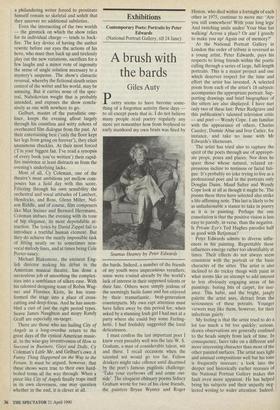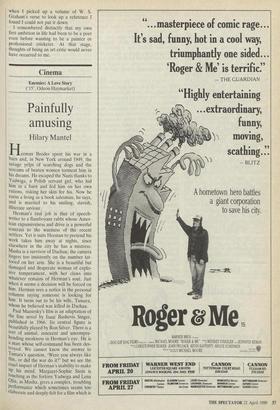Exhibitions
Contemporary Poets: Portraits by Peter Edwards (National Portrait Gallery, till 24 June)
A brush with the bards
Giles Auty
Poetry seems to have become some- thing of a forgotten activity these days to all except poets that is. I do not believe many people read poetry regularly any more yet remember how from boyhood to early manhood my own brain was fired by Seamus Heaney by Peter Edwards the bards. Indeed, a number of the friends of my youth were impecunious versifiers; some were soured already by the world's lack of interest in their supposed talents or their fate. Others were simply jealous of the seemingly facile fame and fun enjoyed by their transatlantic, beat-generation counterparts. My own rapt attention must have fallen away by this period for, when asked by a stunning Irish girl I had met at a party where she could buy some Ferling- hetti, I had foolishly suggested the local delicatessen.
I must confess the last important poet I knew even passably well was the late W. S. Graham, a man of considerable talent, wit and thirst. I recall occasions when the talented wit would go too far. Fellow drinkers might take offence until disarmed by the poet's famous pugilistic challenge: `Take your eyebrows off and come out- side'. The eloquent obituary poems Sidney Graham wrote for two of his close friends, the painters Bryan Wynter and Roger Hinton, who died within a fortnight of each other in 1975, continue to move me: 'Are you still somewhere/ With your long legs/ And twitching smile under/ Your blue hat walking/ Across a place? Or am/ I greedy to make you up/ Again out of memory?'
At the National Portrait Gallery in London this order of tribute is reversed as a young artist, Peter Edwards, pays his respects to living friends within the poetic calling through a series of large, full-length portraits. This is a major project and one which deserves respect for the time and effort the artist has invested. A selected poem from each of the artist's 18 subjects accompanies the appropriate portrait. Sup- porting drawings and brief biographies of the sitters are also displayed. I have met only two of these last: Peter Redgrave and this publication's talented television critic — and poet — Wendy Cope. I am familiar with the appearance of others, Charles Causley, Dannie Abse and Ivor Cutler, for instance, and take no issue with Mr Edwards's likenesses.
The artist has tried also to capture the spiritof the poets through use of appropri- ate props, poses and places. Nor does he spare those whose natural, relaxed ex- pressions incline to testiness or facial fati- gue. It's probably no joke trying to live as a professional poet and in the portraits only Douglas Dunn, Maud Sulter and Wendy Cope look at all as though it might be. The poems these three have selected also strike a life-affirming note. This last is likely to be as unfashionable a stance to take in poetry as it is in painting. Perhaps the one consolation is that the positive vision is less easy-to parody, in verse, than the negative. Is Private Eye's Ted Hughes parodist half as good with Betjeman?
Peter EdWards admits to diverse influ- ences in his painting. Regrettably these influences emerge rather too identifiably at times. Their effects do not always seem consistent with the portrait or the basic character of the sitter. The artist is also inclined to do tricksy things with paint in what seems like an attempt to add interest to less obviously engaging areas of his paintings: boring bits of carpet, for inst- ance. This habit, and the bright, jangly palette the artist uses, detract from the seriousness of these potraits. Younger viewers may like them, however, for their infectious gaiety.
My feeling is that the artist tried to do a lot too much a bit too quickly; serious, drawn observations are generally confined to the heads simply from lack of time. In consequence, faces take on a different and more interesting character than most of the other painted surfaces. The artist uses light and unusual compositions well but his tone is frequently insecure; a look into the deeper and historically earlier recesses of the National Portrait Gallery makes this fault even more apparent. He has helped bring his subjects and their unjustly neg- lected writing to wider attention. Indeed, when I picked up a volume of W. S. Graham's verse to look up a reference I found I could not put it down.
I remembered distinctly that my own first ambition in life had been to be a poet even before wanting to be a painter or professional cricketer. At that stage, thoughts of being an art critic would never have occurred to me.



















































 Previous page
Previous page